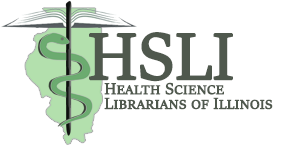“The Practice of Medicine is an art, not a trade, not a business, but a calling in which your heart will be exercised equally with your head.“-William Osler, MD, 1849-1919. I think this quote could read “The Practice of Medical Librarianship is an art.”This conference, Navigating a River of Information, reflected so many talented, innovative, progressive, and enthusiastic medical librarians in so many areas. We also face many challenges, healthcare changes, budget cuts, new technology, and stress.
However, we will and must face these challenges. I was inspired by the conference. I was enthused!! However, now I am back, I see the reality of my small medical library. But wait, Sarah Houghton, the Librarian in Black, stated to be realistic and find ways to do something new. It may be something small, but new to you and your patrons. Demonstrate and teach, you can examine what you have and what you need. Find a way, to improve and be a value to your institution, don’t feel sorry for yourself or your situation, and do what you can. Yes, we all what those new and improved items but find a way to plan for them and over time it might happen. If not, go on!
Michelle Kraft, Keynote speaker, gave a useful presentation on how we can build partners. We need to extend our scope and get out there more. You can make your own library app. The library can partner with others in the community or in the hospital setting. We can be problem solvers and not part of the problem!!
The CE course, Emerging Technologies for Librarians, by Gabriel Rios and Melissa De Santis, was very interesting. It covered smartphones, tablets, iPad, phablets, ereaders, etc. I was impressed by the Garnter Group Emerging Technologies chart. It was a graphic presentation of expected and projected technologies. Some of these are being implemented now like 3D printers. Other like 3D bioprinting is down the line, but very possible. Gabe and Melissa gave a useful presentation on Apps. This will be a great help when I add to my library iPad. An overview of social media platforms was also discussed for personal or library related applications.
The CE course, Promoting Health Literacy through Easy to Read Materials, presented by Samathi Hewakapugue, was very useful in identifying sources for patient information. The range of health literacy was discussed from low reading skills to lack of understanding. It was important to realize that many highly educated people do not understand the medical language. Material should be printed in plain language. This class examined examples of different types of material and the reading levels giving to patients. Is the material in our hospital setting confusing or easy to understand, we will have to review all of our material. This class provided various tools that can be used in helping to develop useful material for our patients in all healthcare areas.
I attended six Concurrent Papers. These included: Library instruction and the first-year medical student by Ryan Rafferty; Building EBP skills in medical students with a longitudinal curriculum integrated plan by Amy Blevins; Navigating the social media stream: smooth sailing on twitter for medical librarians, by Mary Jordan; At the beginning of an odyssey with bioinformatics and the NCBI databases by Edith Starbuck; Replicating Rochester: developing a feasible multi-institution study of users information needs in the health sciences by Jeanne Link and Jonna Peterson; and From beached to re-launch while charting a new course: digitization of a retrospective thesis collection by Jan Cox.
Each presentation gave me new insight into these projects and the research involved. New terms like “ethnographic” and identifying new resources in NCBI were very useful. Also, I have already contacted Amy Blevins from the University of Iowa on her EBP graph and presentation.
In conclusion, “That which is painful instructs.“-Benjamin Franklin, each new technology comes with a learning curve. We are frustrated at the start, but soon we can master the program or tool. Keeping current is very, very relevant in our medical library world; this conference provided us with many ways to do this. It presented free Apps to tools. We gained knowledge that all of us are involved with being a major part of our institutions and how to improve patient care!!!
